Late last week, a number of media outlets in the UK published a series of photographs of a dead blue whale that I took during a recent visit to Sri Lanka (Daily Mail, Mirror, The Sun, Huffington Post).
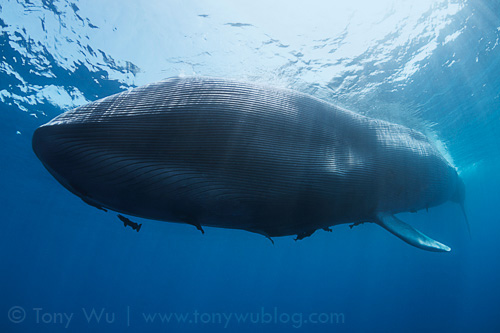
Dead blue whale (Balaenoptera musculus)
I thought it worth augmenting what appeared in the mass media with some additional background information for anyone who might be interested, as well as to add some personal thoughts about the experience.
Cause of Death
Let me start by stating that I cannot be 100% certain that the cause of death was a ship. It is impossible to know exactly what happened without witnessing the actual event.
I put together what I saw with the information I gleaned from other people, and I pieced together a narrative that seemed to make most sense.
The exact text I sent to my media rep was:
“I photographed this whale in the afternoon of 3 April 2012, between five and ten kilometres south of Weligama Bay, which is at the southern tip of Sri Lanka. Many people on whale watching boats saw it.
The whale was not significantly decomposed when I saw it, so it had probably not been dead for very long. My guess is that it may have been struck by a ship during the night, while the animal was resting at the ocean surface.
When whales die, internal decomposition causes gas to build up inside the whale’s body, causing the carcass to bloat. There was no visible bloating, so this suggests the whale had not been dead long when I photographed it.”
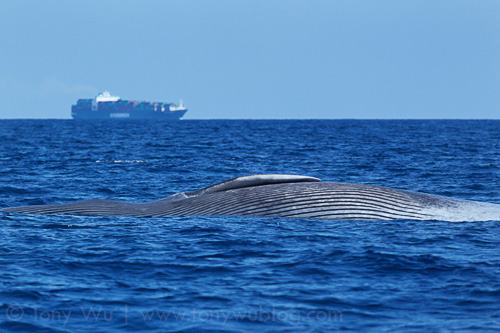
Dead blue whale adrift in an area of heavy shipping traffic
Note that I wrote “My guess is...”, because that’s precisely what it was, an informed supposition, based on the lack of significant decomposition, absence of bloating, the nature of the wound, and the circumstances in which the whale was found.
More specifically, the whale was in a zone of high shipping traffic. Shipping lanes in the vicinity pass through prime blue whale habitat. Humongous ships (ones so big I initially mistook them for islands) cruise through the area on a constant basis.
Another consideration was the fact that another blue whale had arrived in port perched on the leading edge of a ship’s bow just a couple of weeks before I photographed this one.
Of course, nothing is impossible, so there is some chance that the whale died of other causes and was subsequently struck by a passing ship, or that the wound was caused by something else.
One possibility I considered was scavenging by a large shark. The wound was huge, so had it been a shark, it would have been an enormous one. I looked for teeth that may have been lodged in the wound, as well as for scrapes or other signs of scavenging, but was unable to see anything to suggest a large predator was the cause of the wound.
Moreover, there were no signs of any sharks (or any other scavengers) during the entire day, despite the fact that the whale carcass was leaking bodily fluids into the water. If a shark had been nearby, it would be difficult to imagine the fish passing up a free meal as tempting as a dead blue whale.
In the final analysis, the most probable cause of death seemed to be a ship strike.
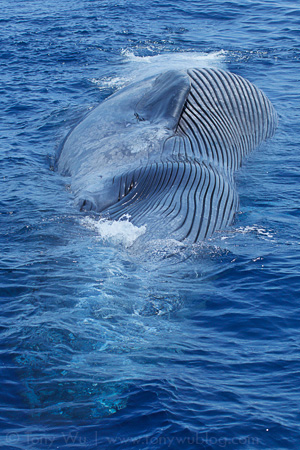
Surface view of the dead blue whale
How Can a Whale be so Stupid? How Can a Ship be so Careless?
It is perhaps natural to wonder how a blue whale, a highly intelligent animal with senses finely attuned to surviving in its environment, could possibly let a loud, gigantic ship sneak up and clobber it.
Similarly, it is probably natural to wonder why ships don’t have a system to avoid such collisions.
Well...I don’t believe it’s really a case of unintelligent whales or negligent ships. It’s probably fair to say that whales avoid ships when they can, and most ships would probably choose to avoid whales as well. In other words, ship strikes happen despite the best of intentions by cetacean and human alike.
There was a good opinion piece that came out in the Independent discussing some of the possible reasons why whales sometimes aren’t able to avoid ships and vice versa. It’s worth a read, as the author does a better job of explaining the scenarios that I probably can.
But in any event, ship strikes on cetaceans are not a particularly unusual occurrence.
In fact, the International Whaling Commission (IWC) has a database of documented ship strikes, which you can access on this page: http://iwcoffice.org/sci_com/shipstrikes.htm
If you download and view the Excel file, you’ll see that there are a lot of entries, from all over the world, involving many cetacean species.
The IWC database is neither comprehensive nor definitive. There is inherent uncertainty when considering ship strikes, because there is no way that every incident is reported, and there is always the possibility of mistakes being made.
But...if you look at the table...there is little doubt that ship strikes are a serious issue. And with levels of commercial maritime traffic on the rise, it stands to reason that the chances of ship strikes are also growing. Of course, not all ship strike incidents are by large commercial vessels. Some involve whale-watching boats, military vessels, or private leisure craft.
One other thing worth noting from the file is the range of species: blues, fins, humpbacks, rights, orcas, sperms, Bryde’s, grays, and more.
Many people understandably get upset about the practice of whaling. It’s bloody, cruel, and arguably unnecessary. But whaling is targeted to specific species, mostly minke whales. By most estimates, there are hundreds of thousands of minke whales. That’s not an endorsement of whaling by any means (i.e., don’t flame me for stating a fact).
But the thing about ship strikes is that they are indiscriminate. Ships inadvertently injure and kill many species, including ones that are in serious trouble, such as blue whales or right whales in the North Atlantic, both listed as endangered on the IUCN Red List.
That’s an issue worth mulling over. The loss of a single blue whale or North Atlantic right whale represents a disproportionately large impact on those species’ depleted populations. And yet, there is not nearly as much public concern about ship strikes as there is about whaling.
Doesn’t seem right, does it?
For reference, here are whale population estimates from the IWC: http://iwcoffice.org/conservation/estimate.htm
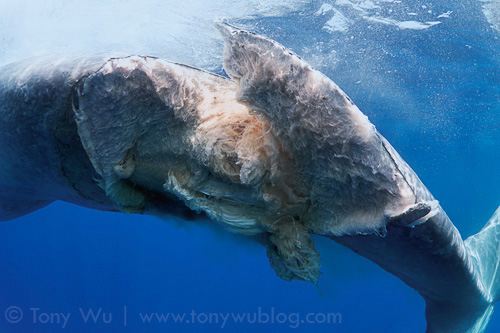
Close-up view of the dead blue whale's wound
A Bit of Math
To provide a sense of scale and perspective for what happens when a large commercial vessel and a whale meet, here are some representative numbers:
Blue whale: Let’s way(!) overestimate and say 30 metres long and 200 metric tonnes (200,000kg).
vs.
Example large container ship: 350 metres in length carrying 10,000 TEUs, with each TEU representing an average of 15,000kg = 150,000 metric tonnes, before accounting for the ship’s mass
You can certainly dispute my very-rough assumptions, but the end conclusion remains the same: a blue whale, as large as it seems to us, is puny by comparison to a large commercial vessel, both in size and mass.
In addition, large commercial ships can cruise at 20+ knots in open ocean (37km/ hr, 23mph), which means any cetacean that happens to be in the way doesn’t stand a chance. It also means that it’s very difficult for a large ship to change course quickly, even if it notices something in its path and tries to avoid it.
Thoughts About Sri Lanka
Although this specific experience was in the waters of Sri Lanka, I think it important to underscore that this is not an issue that is unique to that country. In fact, as is apparent in the IWC file, this is a global dilemma. Cetacean deaths from ship strikes occur in shipping lanes around the world.
It just so happens that there are active shipping lanes just south of Sri Lanka, where many large ships travel at high speed, ferrying consumer goods and supplies among major ports. And it just so happens that there is a nascent whale-watching industry in Sri Lanka, which is how I and other people ended up seeing this specific blue whale.
My view is that the development of a whale-watching industry in Sri Lanka is positive. It generates tourism revenue, introduces people (both locals and visitors) to the wonders of the oceans, and hopefully, in the long run, provides incentive to protect the whales, other marine organisms, and aquatic ecosystems in general.
Sri Lanka is a wonderful place, somewhere I may have never had the opportunity to visit were it not for the whales.
There are, however, challenges to be overcome, the most immediate of which stems from the rapid profusion of boats and visitors. As in other locations where marine-based tourism is popular, boating discipline on the water is of paramount importance.
Lots of boats trying to please lots of people, all of whom want to see lots of whales..is a situation that can potentially lend itself to less-than-ideal behaviour at sea. The challenge for all concerned is to understand and accept that in the long-term, safe encounters that don’t harass animals or place people at risk are the only way to ensure a solid reputation, ongoing revenue and happy cetaceans.
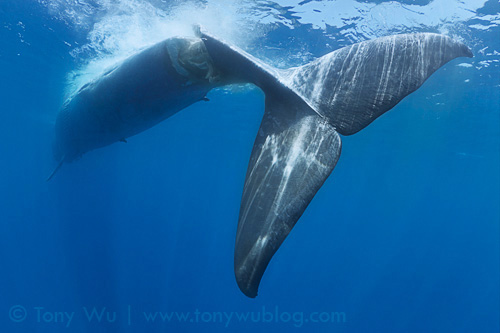
Rear view of the dead blue whale
The Silver Lining?
Whenever something bad happens, it’s a good idea to look for the silver lining.
I don’t know yet if there will be one that appears from this situation, but I’m hoping that documentation of this dead blue whale, as well as the one that was photographed in March this year, may give occasion for pause...for concerned people from many different walks of life to consider whether there may be a constructive way to reduce the chances of ship strikes taking place in Sri Lanka, with minimal, or ideally no, disruption to the flow of commercial shipping traffic.
On the positive side, there are existing examples of shipping companies, cetacean researchers and conservationists working together to do exactly this, notably in the North Atlantic to protect the few remaining North Atlantic right whales.
But to get to such a position, there must be consensus that this issue needs to be studied and addressed, and then, there needs to be sufficient funding dedicated to this task...funding for data collection about the ocean, about the blue whales and other large marine fauna in the area, and about shipping traffic...in order to derive conclusions and recommendations based on fact.
It’s easy, and tempting, to demand justice now(!) for the whales. But getting emotional rarely solves problems; it often exacerbates them.
In the long run, only meticulous gathering and analysis of data can lead to positive change.
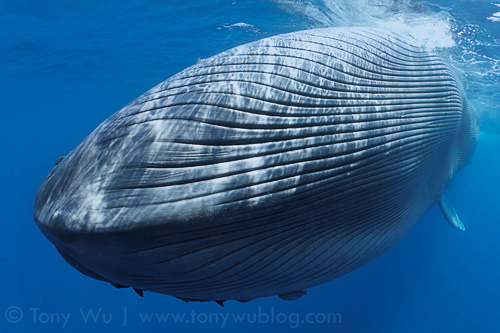
Close-up view of the dead blue whale's throat grooves